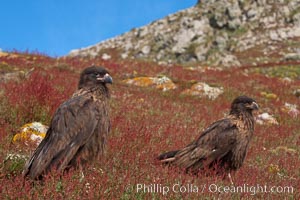
Straited caracara, a bird of prey found throughout the Falkland Islands. The striated caracara is an opportunistic feeder, often scavenging for carrion but also known to attack weak or injured birds.
Species: Striated caracara, Phalcoboenus australis
Location: Steeple Jason Island, Falkland Islands, United Kingdom
Image ID: 24277
Species: Striated caracara, Phalcoboenus australis
Location: Steeple Jason Island, Falkland Islands, United Kingdom
Image ID: 24277

Krill. A thin cloud of pink krill gathers at the ocean surface, where it is likely to be preyed upon by sharks, fish, birds and whales.
Location: San Diego, California
Image ID: 27014
Location: San Diego, California
Image ID: 27014
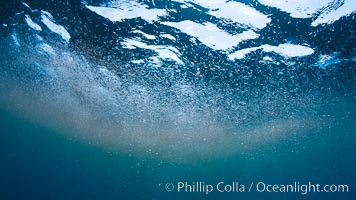
Krill. A thin cloud of pink krill gathers at the ocean surface, where it is likely to be preyed upon by sharks, fish, birds and whales. Likely Euphausia pacifica.
Location: San Diego, California
Image ID: 27016
Location: San Diego, California
Image ID: 27016
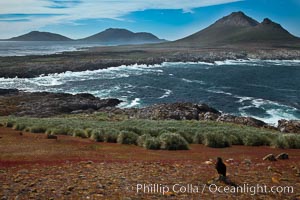
Steeple Jason Island, striated caracara in the foreground, southwestern exposure, looking south pass the isthmus toward the southern half of the island. Steeple Jason is one of the remote Jason Group of Islands in the West Falklands. Uninhabited, the island is spectacular both for its rugged scenery and its enormous breeding colony of black-browed albatross. Steeple Jason Island is now owned and administered by the Wildlife Conservation Society.
Species: Striated caracara, Phalcoboenus australis
Location: Steeple Jason Island, Falkland Islands, United Kingdom
Image ID: 24161
Species: Striated caracara, Phalcoboenus australis
Location: Steeple Jason Island, Falkland Islands, United Kingdom
Image ID: 24161
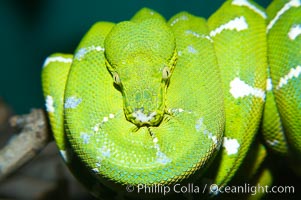
Emerald tree boa. Emerald tree boas are nocturnal, finding and striking birds and small mammals in complete darkness. They have infrared heat receptors around their faces that allow them to locate warm blooded prey in the dark, sensitive to as little as 0.4 degrees of Fahrenheit temperature differences.
Species: Emerald tree boa, Corralus caninus
Image ID: 13965
Species: Emerald tree boa, Corralus caninus
Image ID: 13965
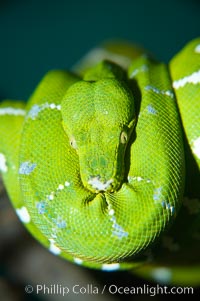
Emerald tree boa. Emerald tree boas are nocturnal, finding and striking birds and small mammals in complete darkness. They have infrared heat receptors around their faces that allow them to locate warm blooded prey in the dark, sensitive to as little as 0.4 degrees of Fahrenheit temperature differences.
Species: Emerald tree boa, Corralus caninus
Image ID: 13966
Species: Emerald tree boa, Corralus caninus
Image ID: 13966
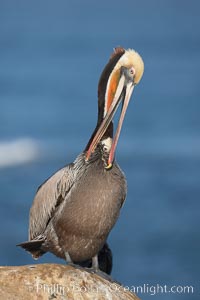
Brown pelican preening. After wiping its long beak on the uropygial gland near the base of its tail, the pelican spreads the preen oil on feathers about its body, helping to keep them water resistant, an important protection for a bird that spends much of its life diving in the ocean for prey.
Species: Brown Pelican, Pelecanus occidentalis, Pelecanus occidentalis californicus
Location: La Jolla, California
Image ID: 18383
Species: Brown Pelican, Pelecanus occidentalis, Pelecanus occidentalis californicus
Location: La Jolla, California
Image ID: 18383

Brown pelican preening. After wiping its long beak on the uropygial gland near the base of its tail, the pelican spreads the preen oil on feathers about its body, helping to keep them water resistant, an important protection for a bird that spends much of its life diving in the ocean for prey.
Species: Brown pelican, Pelecanus occidentalis, Pelecanus occidentalis californicus
Location: La Jolla, California
Image ID: 18384
Species: Brown pelican, Pelecanus occidentalis, Pelecanus occidentalis californicus
Location: La Jolla, California
Image ID: 18384
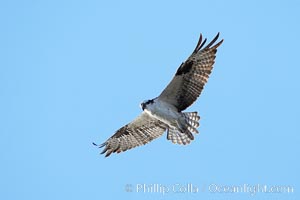
Osprey soaring.
Species: Osprey, Pandion haliaetus
Location: Bolsa Chica State Ecological Reserve, Huntington Beach, California
Image ID: 19911
Species: Osprey, Pandion haliaetus
Location: Bolsa Chica State Ecological Reserve, Huntington Beach, California
Image ID: 19911

Osprey catches a small fish from a lagoon.
Species: Osprey, Pandion haliaetus
Location: Bolsa Chica State Ecological Reserve, Huntington Beach, California
Image ID: 19912
Species: Osprey, Pandion haliaetus
Location: Bolsa Chica State Ecological Reserve, Huntington Beach, California
Image ID: 19912
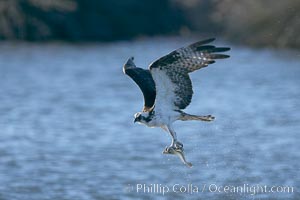
Osprey catches a small fish from a lagoon.
Species: Osprey, Pandion haliaetus
Location: Bolsa Chica State Ecological Reserve, Huntington Beach, California
Image ID: 19913
Species: Osprey, Pandion haliaetus
Location: Bolsa Chica State Ecological Reserve, Huntington Beach, California
Image ID: 19913
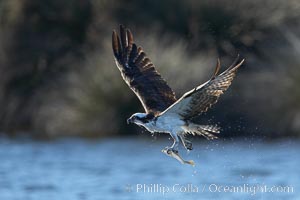
Osprey catches a small fish from a lagoon.
Species: Osprey, Pandion haliaetus
Location: Bolsa Chica State Ecological Reserve, Huntington Beach, California
Image ID: 19914
Species: Osprey, Pandion haliaetus
Location: Bolsa Chica State Ecological Reserve, Huntington Beach, California
Image ID: 19914